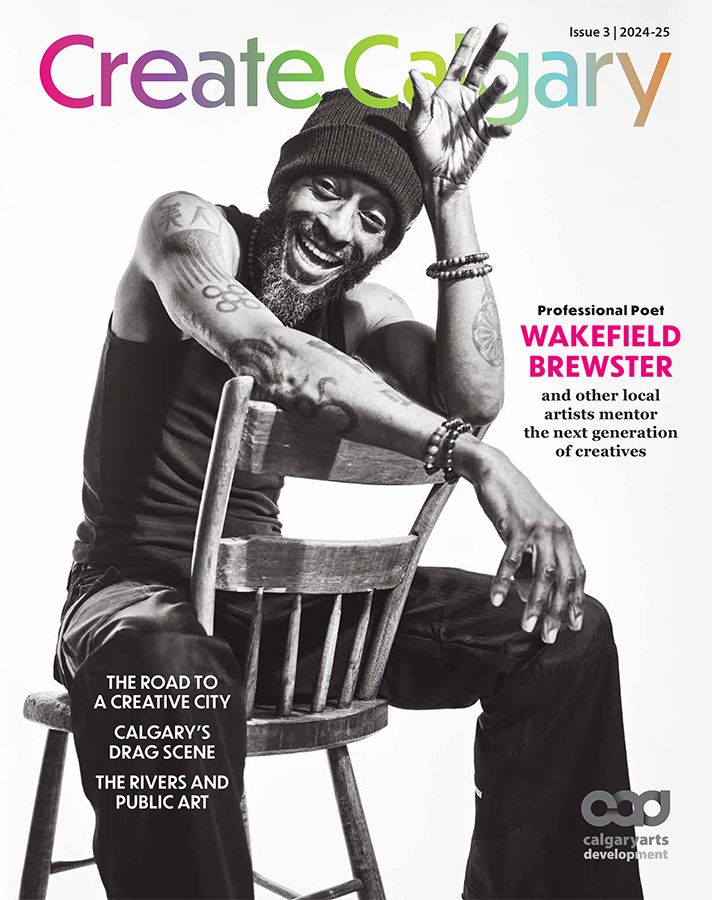Poetry, Dance and Music for Reconciliation
New Blood brings healing and understanding to Indigenous history
New Blood was created by Strathmore High School’s drama and dance teacher, Deanne Bertsch, in collaboration with the school’s former Blackfoot language teacher, Eulalia Running Rabbit. Inspired by Siksika Nation’s former Chief Vincent Yellow Old Woman’s experience at residential school and how he reclaimed his life, the show mixes poetry, contemporary and traditional dance and music, and features Indigenous and non-Indigenous students. “The play brings healing and understanding,” says Running Rabbit, co-director and narrator of New Blood. “A lot of people don’t know about the residential school experience and what the students went through. We’re here to share that experience.”

Running Rabbit, a residential school survivor herself, is reminded of her experience when she performs, and she often thinks of a classmate who passed away. Running Rabbit was a day-school student, which meant that she was allowed to return home in the evenings. Each morning, she was bussed back to school where her friend would be waiting for her. “The first thing we’d do is run up the stairs and look out the window. Always looking out the window. One day, I asked her, ‘Why must you look out the window all the time?’ And she goes, ‘Hoping to see my parents coming for me.’ As young as I was, I knew how it felt to be lonely.”
Even now, when Running Rabbit thinks about her friend, “sometimes I still break down.”
Though painful, Running Rabbit knows it’s an important story to tell. She remembers when Bertsch approached her to participate in the play. Running Rabbit agreed though they didn’t know how big it would turn out to be. When they performed for the first time, they realized how powerful it was and took it to Siksika High School, where they were just as successful. They had buy-in from both Indigenous and non- Indigenous audiences.



Bertsch’s goal at the time was to create a piece of theatre that included the history of the Blackfoot students in her class and for non- Indigenous students to learn more about the stories of the original inhabitants of this land. “In 2014, I went to Writing-on-Stone Provincial Park and toured the writings and pictographs, which tell the history of the Blackfoot people,” says Bertsch. “The Blackfoot guide told us that some of the stories have been lost when the Blackfoot people were put on reserves in the late 1800s, and weren’t able to learn their history.”
She then decided to talk to Running Rabbit about the history that changed the way of life for Blackfoot people. While speaking with Running Rabbit, Bertsch learned about the many factors that continue to affect Indigenous peoples today. Running Rabbit touched on the fur trade, reserves, residential schools and why her people still struggle with addiction. “She talked a lot about healing,” says Bertsch. “And she wanted the show to be about that.”


So, the two teachers set forth on a journey to create an informative play, and it so happened that one of Berstch’s students was the grandson of Chief Vincent Yellow Old Woman. That student connected the teachers with the Chief who generously shared his story of going through residential school, the trauma it inflicted upon him and how he found hope and healing to become Chief of his people. “That became the backbone of our story and how we told it,” says Bertsch.
Though she admits that using English popstar Peter Gabriel’s music throughout the show may sound like a strange choice, Bertsch says that when listening to the lyrics, a lot of his work had anti-colonial undertones that criticized the apartheid in South Africa. Indigenous peoples in Canada had similar experiences of forced assimilation and trauma as Black South Africans. “We started choreographing with his music,” says Bertsch. “And the Chief gave us an amazing poem called Indian in the Child,” written by Cree Métis artist Sandra Sutter and Jim Pearce based on the Chief’s life.



The play is told through movement and dance and covers topics such as the fur trade, smallpox pandemic, residential schools, trauma and addiction. While these are difficult topics and current realities for many Indigenous peoples, this story is one of hope and healing.
“It’s been a really amazing journey,” says Bertsch. “It gives our Indigenous student performers an opportunity to be seen and honoured. It celebrates Indigenous culture in our school and has fostered new relationships where there haven’t been relationships before.”
New Blood has been performed more than 300 times across Western Canada with about 150 students and 14 different casts. Coming up on its 10-year anniversary, New Blood has a CBC documentary about its evolution being released on November 22, 2024 — nearly a decade since its first performance.
While Canadians have likely heard about residential schools through media and social studies curriculum, New Blood offers a different way of helping people understand and empathize with the loss that happened.
Running Rabbit agrees and believes the show’s message will continue to reach many. It’s an important story about reconciliation, and even after 10 years, people still want to hear this story, if not more so. Running Rabbit remembers daydreaming as a little girl in residential school and wondering what her future would hold.

“My dream came true when we played at the Jack Singer Concert Hall with the orchestra,” she says. “We got to do the play where all these famous people come to do their shows or music. It was just amazing.”
Learn more at newblooddance.net.
This article was originally published in the 2024 edition of Create Calgary, an annual magazine launched by Calgary Arts Development to celebrate the work of artists who call Mohkinsstsis/Calgary home.
You can pick up a free copy at public libraries, community recreation centres and other places where you find your favourite magazines. You can also read the digital version online here.

